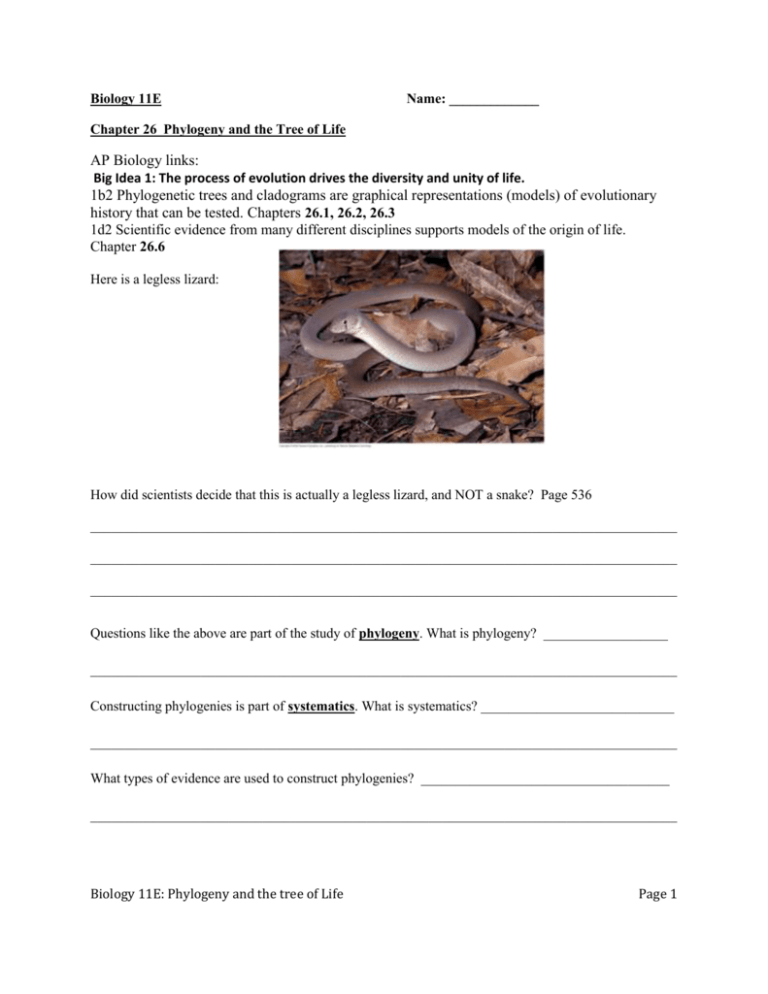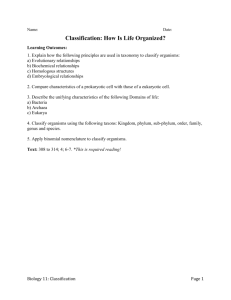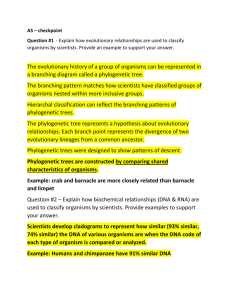File - Frykberg Science
advertisement

Biology 11E Name: _____________ Chapter 26 Phylogeny and the Tree of Life AP Biology links: Big Idea 1: The process of evolution drives the diversity and unity of life. 1b2 Phylogenetic trees and cladograms are graphical representations (models) of evolutionary history that can be tested. Chapters 26.1, 26.2, 26.3 1d2 Scientific evidence from many different disciplines supports models of the origin of life. Chapter 26.6 Here is a legless lizard: How did scientists decide that this is actually a legless lizard, and NOT a snake? Page 536 _____________________________________________________________________________________ _____________________________________________________________________________________ _____________________________________________________________________________________ Questions like the above are part of the study of phylogeny. What is phylogeny? __________________ _____________________________________________________________________________________ Constructing phylogenies is part of systematics. What is systematics? ____________________________ _____________________________________________________________________________________ What types of evidence are used to construct phylogenies? ____________________________________ _____________________________________________________________________________________ Biology 11E: Phylogeny and the tree of Life Page 1 DNA evidence has been used to clarify the following evolutionary relationships between animals, fungi and plants Without this type of evidence, most people would think that fungi are more closely related to ____________________ than they are to humans. Choose any organism, animal or plant and research why it has been grouped with others of the same family as it. (you will report back next class) Biology 11E: Phylogeny and the tree of Life Page 2 Concept 26.1 Phylogenies show evolutionary relationships Start by viewing the Activity: Classification Schemes under Concept 26.1 on the website. In studying phylogenies, we will first look at how organisms are named and classified. The naming and classifying of organisms is called ______________________. Organisms are named using the __________________ system first introduced by ____________________________________. In the example at the right, the panther is called Panthera pardus. The first part of the name is the ___________ that the organism belongs in. The second part of the name, the species epithet, represents the ___________________ of the organism within that genus. The first letter of the genus name is _______________________ and the whole name is written in ___________________. Linnaeus also introduced the hierarchical system of classification where each taxonomic level is increasingly inclusive . In this system, what is a taxon? ___The named taxonomic unit at any level. (taxa = pleural) Carnivora is a taxon at the order level. _ Biology 11E: Phylogeny and the tree of Life Page 3 How closely related are domesticed cats to panthers? Phylogenetic trees are used to show the evolutionary history of a group of organisms. For example, this phylogenetic tree shows evolutionary relationships between some carnivores: Evolutionary relationships are often represented as a series of dichotomies, or two-way branch points. o Each branch point represents the divergence of two evolutionary lineages from a common ancestor. This diagram, show the relationship between classification and phylogeny. Biology 11E: Phylogeny and the tree of Life Page 4 What does each of the branch points of a phylogenetic tree represent? _ This tree traces possible evolutionary relationships between some of the taxa within order carnivora. The most common ancestry between species is illustrated here. _________________ The following generalized diagram shows some characteristics of a typical phylogenetic tree: On the phylogenetic tree above, use a ‘1’ to indicate the common ancestor of Taxa A, B, and C. Put a ‘2’ at the common ancestor of Taxa B and C. Why are B and C called ‘sister taxa’? Sister taxa are groups of organisms that share an immediate common ancestor and are each other’s closest relatives. Why do we say that this tree is ‘rooted’? __ A rooted tree includes the most recent common ancestor to all taxa in the tree. What is a ‘polytomy’? An unresolved pattern of divergence where more than two descendent groups emerge. The term basal taxon refers to a lineage that diverges early in the history of a group, lying on a branch that originates near the common ancestor of the group. Three key points about phylogenetic trees should be emphasized. 1. Phylogenetic trees are intended to show patterns of descent, not phenotypic similarity. Closely related organisms may resemble one another due to common ancestry, but may not if their lineages have evolved at different rates or faced very different environmental conditions. 2. The sequence of branching in a tree reflects patterns of descent and does not indicate the absolute ages of particular species. Biology 11E: Phylogeny and the tree of Life Page 5 3. A taxon in a phylogenetic tree did not evolve from an adjacent taxon. Rather, both taxa evolved from a common ancestor. A species’ phylogeny can provide useful information. o From a phylogeny of corn based on DNA data, researchers have identified two closely related species of wild grasses that may serve as “reservoirs” of beneficial alleles. These alleles may be transferred to cultivated corn by plant breeding or genetic engineering. o Phylogenetic trees played a role in demonstrating that “whale meat” sold in Japan was illegally harvested from protected species. Here is a practical application of a phylogenetic tree. This, in particular, is a gene tree: (see pp 539-540) Inquiry on page 539 What is the species of food being sold as whale meat? Read about the situation and answer these questions: Where did the unknown samples come from? ___Fish markets in Japan____ What evidence was used to construct the phylogenetic tree? __A section of mitochondria DNA was sequenced and compared to the mitochondrial DNA of known whale species. Which of the unknown samples were actually found to be illegal whale meat? _ Minke, humpback and fin whale. Biology 11E: 116103957 Page 6 of 23 Do Concept Check 26.1 on p 540. Biology 11E: 116103957 Page 7 of 23 Concept 26.2 Phylogenies are inferred from morphological and molecular data In constructing phylogenies, why is it important to look at homologous structures and homologous molecular sequences, such as are found in DNA? ____________________________________________ ______________________________________________________________________________ Which homologies are more useful in determining phylogenies, morphological homologies, or molecular homologies and why? Organisms that share similar morphologies or DNA sequences are likely to be more closely related than organisms without such similarities. The moles pictured at the right seem to share many common morphological features. We say these structures are analogous because they have evolved as a result of similarities in the organisms’ __environment/habitat__ and not because they share a close common ancestor Australian mole on top and North American mole on bottom. These organisms are similar because they have undergone convergent evolution as opposed to divergent evolution. It is important to separate phenotype from genotype when constructing phylogenetic trees. Biology 11E: 116103957 Page 8 of 23 With respect to DNA, if genes in two different organisms share many portions of their nucleotides, then we say the genes are _________________________________. The more similar the genes ________________________________________________________. This diagram shows how computer programs can be used to find and align homologous regions that would not be obvious to a casual observer: o If the genes in two organisms have very similar nucleotide sequences, it is highly likely that the genes are homologous. It may be difficult to carry out molecular comparisons of nucleic acids. The first step in molecular comparisons is to align nucleic acid sequences from the two species being studied. o In closely related species, sequences may differ at only one or a few sites. o Distantly related species may have many differences or sequences of different length. As with morphological characters, it is necessary to distinguish homology from analogy to determine the usefulness of molecular similarities for reconstruction of phylogenies. o Very similar sequences are most likely homologies. o In distantly related organisms, identical bases in otherwise different sequences may simply be coincidental matches or molecular homoplasies. Computer programs can also indicate whether matching DNA bases are simply coincidental (a molecular homoplasy) or actually homologous. The example at the right has been determined to be a molecular homoplasy rather than a homologous sequence indicative of a common ancestor. The discipline that analyzes molecular data such as this to determine phylogenetic relationships is called ___molecular_____ systematics. Do Concept Check 26.2 Biology 11E: 116103957 Page 9 of 23 Concept 26.3 Shared characters are used to construct phylogenetic trees In cladistics, scientists put species into groups called ___________________, which include the common ancestor of all the species in the clade. The goal in this type of systematics is to create ___________________ groups or clades, because these groups show the __________________________ relationship between the species. If species are placed in _____________________________ or _________related_________ groups, the correct evolutionary relationship is not shown by the groupings. To identify clades, biologists identify shared ancestral characters and shared derived characters. A shared ancestral character is one that originated in an __ancestor____ of the clade, such as the vertebral column of mammals. A shared derived character is one that is an evolutionary novelty unique to a particular clade, such as hair in all mammals. Hair uniquely identifies the clade of mammals from other vertebrates. The presence of a backbone can qualify as a shared derived character, but at a deeper branch point that distinguishes all vertebrates from other mammals. o Among vertebrates, the backbone is a shared ancestral character because it evolved in the ancestor common to all vertebrates. In a character table, a _0__ indicates that the character is absent in a group, and a __1_ indicates that the character is present. Biology 11E: 116103957 Page 10 of 23 Character tables can be used to construct possible phylogenetic trees. This example shows how a phylogenetic tree for vertebrates could be constructed: The group that diverged before the group we are studying is used for comparison, and is called the ___________________________. In the above example, this group is represented by the ___________________________, which does not have a backbone, but is similar to vertebrates in many ways. Relative amounts of genetic change can be seen in the following phylogenetic tree by comparing the total horizontal line from the common ancestor. Which organism has undergone the most genetic change in this lineage? ____________________________________ The least? __ Biology 11E: 116103957 Page 11 of 23 In this phylogenetic tree, we see that all the organisms have been evolving for the same amount of time, but we can also see how long ago each group diverged from the others: How long ago did the mouse line diverge from the human line? ___________________________. The amphibian group from the chicken/human/mouse group? ____________________________ In constructing phylogenetic trees, scientists use two principles: Maximum parsimony: __the fewest base changes between an organism and its ancestor and therefore the fewest evolutionary differences. __ Maximum likelihood: ___the most likely sequence of evolutionary events. ___ Phylogenetic trees are hypotheses. Any phylogenetic tree represents a hypothesis about how the organisms in the tree are related. o The best hypothesis is the one that best fits all the available data. Biology 11E: 116103957 Page 12 of 23 We can use phylogenetic trees to predict characteristics of fossil organisms, such as dinosaurs. Which modern group of organisms would be most similar to dinosaurs? o o o o o o Evidence suggests that birds descended from a group of bipedal Saurischian theropod dinosaurs. The closest living relatives of birds are crocodiles. Birds and crocodiles share a number of features: Both have four-chambered hearts. Both “sing” to defend territories and attract mates. Both brood their eggs, birds by sitting on them and crocodiles by covering their eggs with their neck. Based on these observations, biologists predict that dinosaurs had four-chambered hearts, sang, and brooded eggs in nests. The fossil record does not provide evidence of dinosaur heart structure or singing behavior. However, fossilized dinosaur nests have been found with fossilized adults crouched over the eggs in a brooding posture. This evidence provides independent data supporting the hypothesis that birds descended from dinosaurs. Biology 11E: 116103957 Page 13 of 23 Here is fossil evidence that supports the prediction that dinosaurs have nests and brood their eggs: Concept 26.4 An organism’s evolutionary history is documented in its genome Why is the DNA that codes for rRNA useful in studying relationships between taxa that diverged hundreds of millions of years ago? The DNA that codes for ribosomal RNA (rRNA) changes relatively slowly, so DNA sequences in these genes can be compared to sort out relationships between taxa that diverged hundreds of millions of years ago. o Studies of rRNA sequences indicate that fungi are more closely related to animals than to plants. o In contrast, mitochondrial DNA (mtDNA) evolved relatively recently and can be used to explore recent evolutionary events, such as relationships between groups within a species. o One research team has used mtDNA to trace the relationships between Native American groups. Biology 11E: 116103957 Page 14 of 23 Concept 26.5 Molecular clocks help track evolutionary time Because the rate of mutation in specific genes tends to remain constant, we can use the number of mutations as an indication of how long ago two species diverged and how long ago gene duplication occurred. This means we have a molecular clock to measure evolutionary time. The following mammalian molecular clock was constructed using the code for seven different proteins: Refer to figure 26.19 on page 550 If two mammals show 40 nucleotide differences in these particular protein codes, approximately how long ago did the species diverge from each other? __________________________ Biology 11E: 116103957 Page 15 of 23 Here is a molecular clock constructed from a gene in HIV. By projecting backwards, when did the first AIDS virus emerge into the human population? ________________________ Refer to fig. 26.20 on page 551 Biology 11E: 116103957 Page 16 of 23 26.6 New information continues to revise our understanding of the tree of life. Molecular systematics has allowed scientists to refine their understanding of how modern day organisms should be classified. As a result, we have moved from a two kingdom system: to a five-kingdom system: to the modern three-domain system: Biology 11E: 116103957 Page 17 of 23 Evidence from the analysis of the DNA that codes for rRNA has allowed scientists to construct the following possible tree of life. Note that only the three branches shown in red above represent multicellular organisms. Most of the history of life has been dominated by single-celled organisms. Biology 11E: 116103957 Page 18 of 23 This simplified tree of life indicates that there has been exchange of genes between the three domains (indicated by the white arrows) at various times in the history life. Evidence suggests that there have been many such horizontal gene transfers. 1. Next to each picture below, name and briefly describe the domain that it represents. I _________________________________________________________________ Biology 11E: 116103957 Page 19 of 23 _________________________________________________________________ ____________________________________________________ II ___________________________ III ________________________________________________________________________ ________________________________________________________________________ __________________________________________ Biology 11E: 116103957 Page 20 of 23 __________________________________________ ________________________________________________________________________ ________________________________________________ http://www.youtube.com/watch?v=BQ1JaYxBH40&feature=fvw classification on you tube. 2. Use the table to briefly explain how the kingdoms of Domain Eukarya are divided. Kingdom Uni or Type of nutrition multicellular Biology 11E: 116103957 Page 21 of 23 Other relevant information Multiple kingdoms Kingdom Uni or Type of nutrition multicellular Biology 11E: 116103957 Page 22 of 23 Other relevant information Past exam question (2011) Explain THREE methods that have been used to investigate the phylogeny of organisms. Describe a strength or weakness of each method. Methods (1 point) Fossils (paleontology) Anatomy/morphology Embryology/development Molecular traits (amino acid sequence in proteins or base sequence in DNA) Behavioral traits Biology 11E: 116103957 AND Strengths (1 point) Determine time; reveal extinct species. Homologous structures indicate evolutionary relationships. Reveals similarities in structures and patterns of development that are not evident in adults. Large numbers of traits. Allow study of evolution between closely related species. Most accurate. Some behaviors are genetic (e.g., frog calls). Page 23 of 23 OR Weaknesses (1 point) Not all species leave fossils. Fossil record is incomplete. Analogous structures. Some taxa have little diversity (e.g., bacteria). Some morphology reflects environment or diet. Similarities between species may be lost in later development. No (or little) data for extinct species. Variation within species blurs differences between species. Behavior maybe culturally transmitted or learned (e.g., bird calls).








